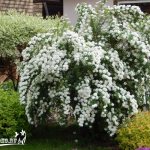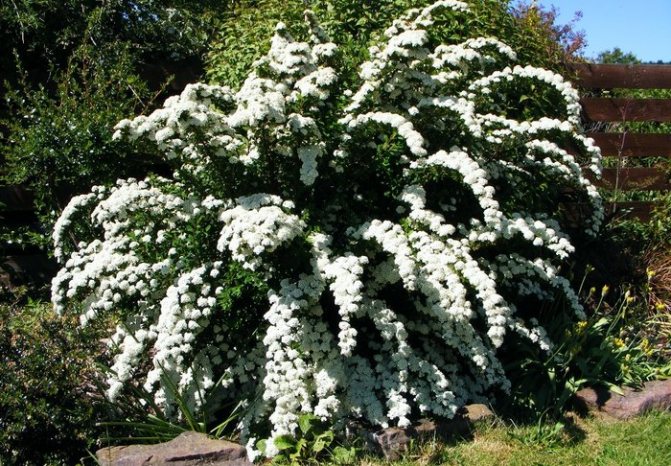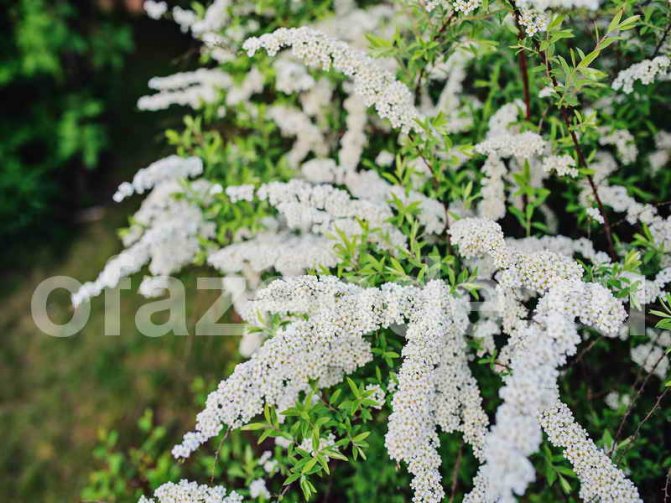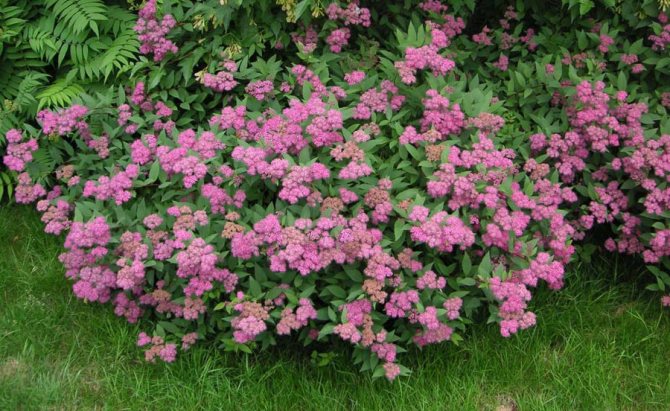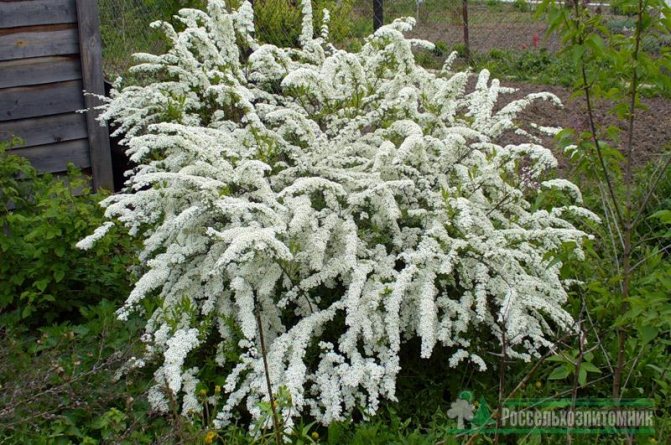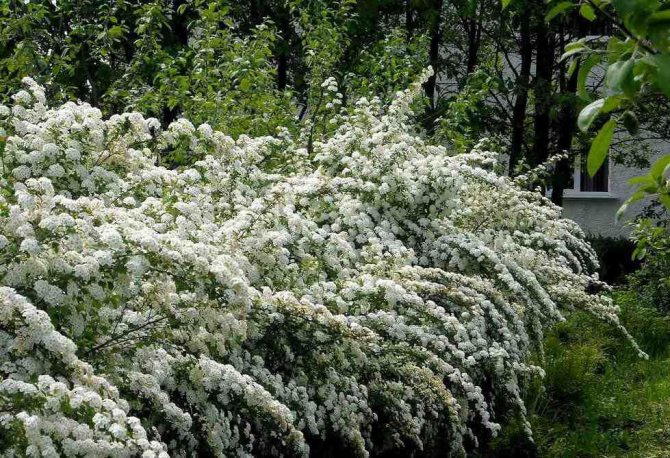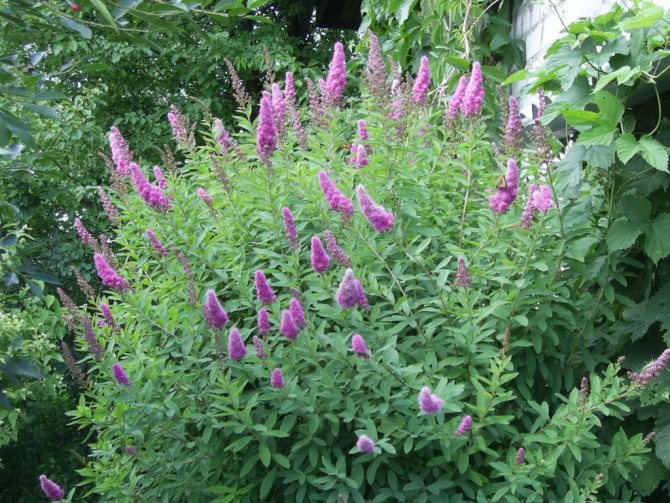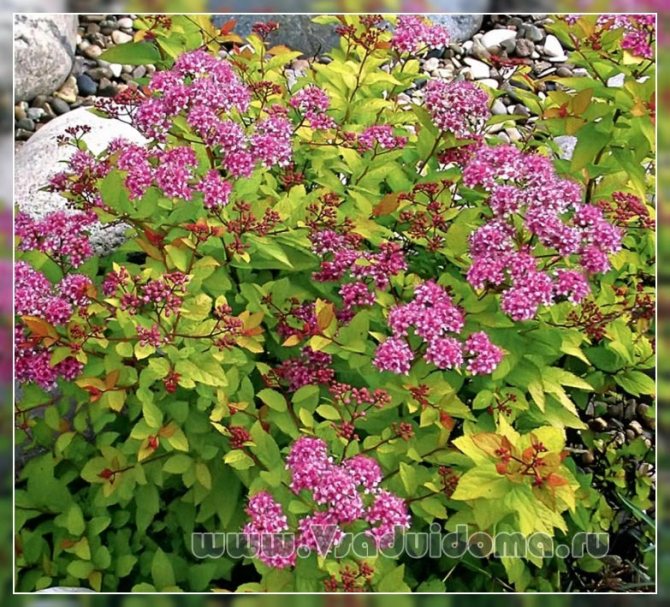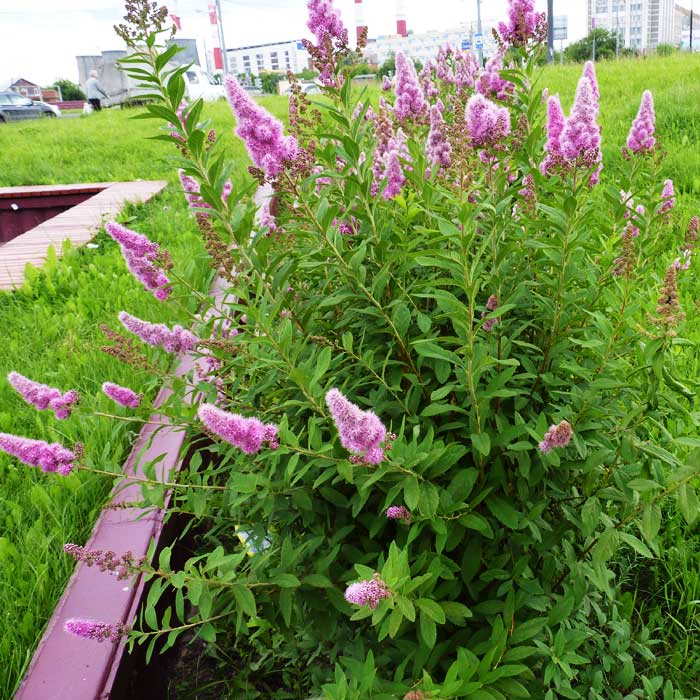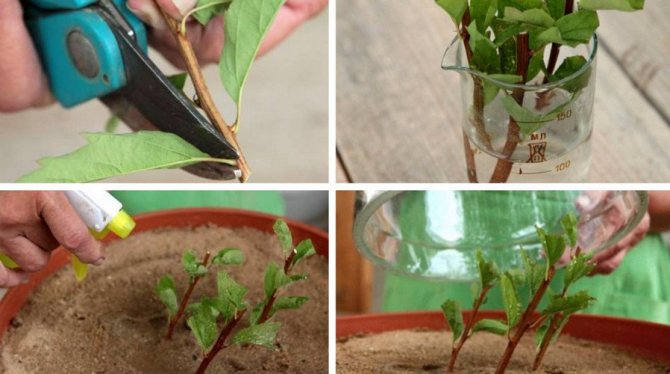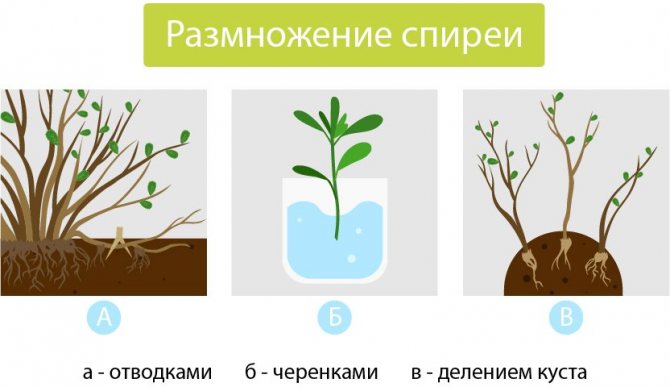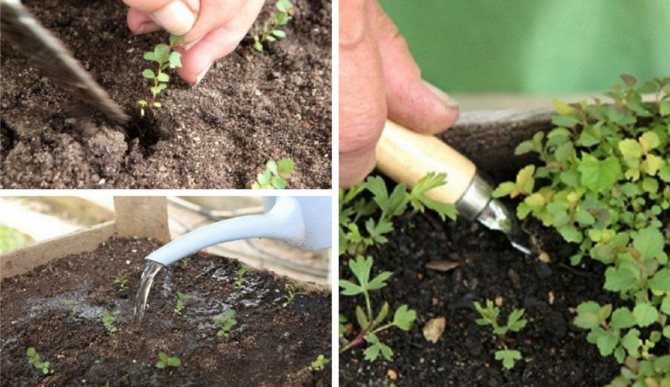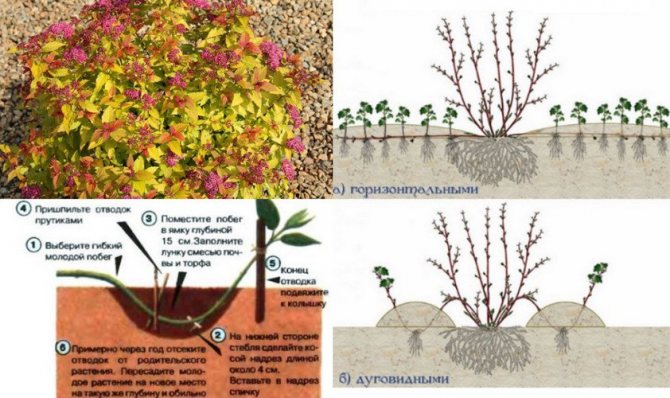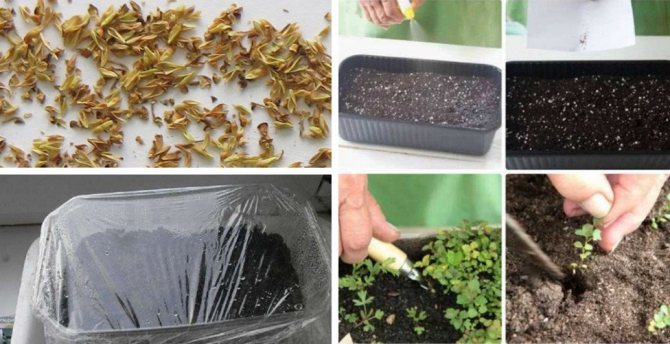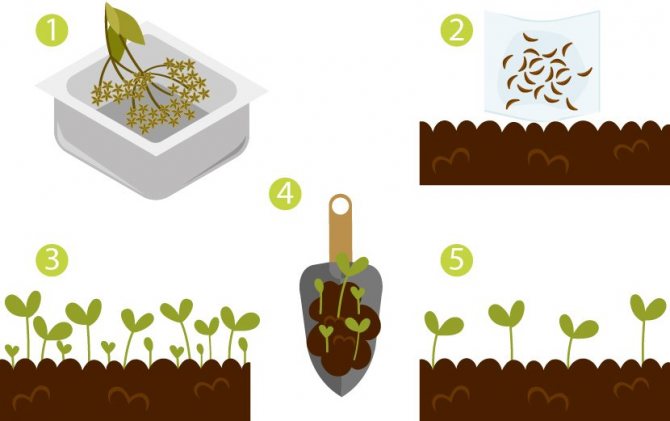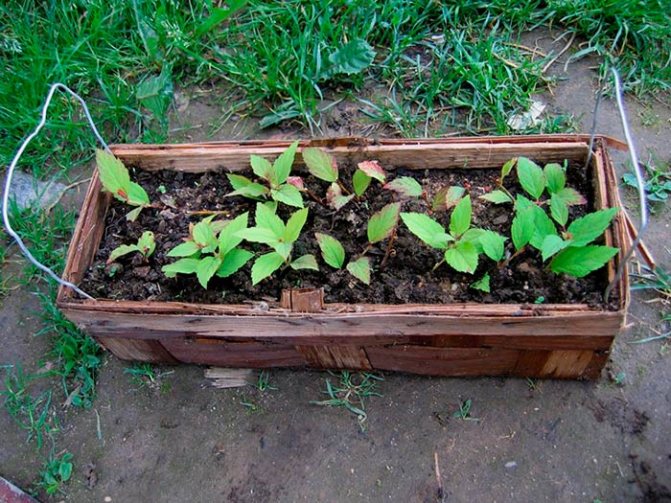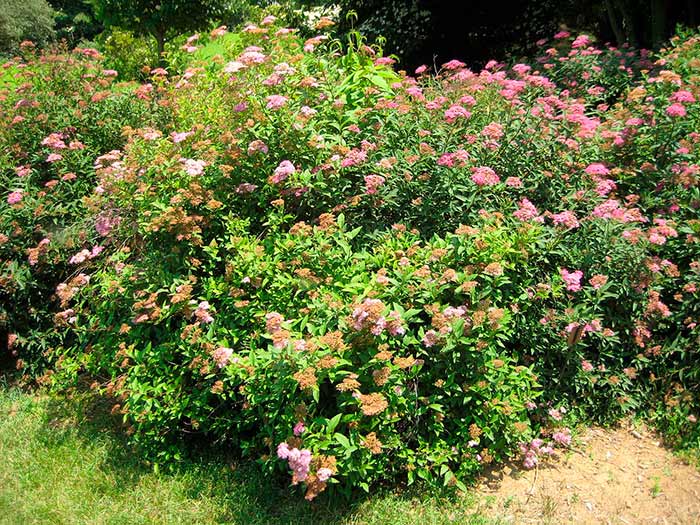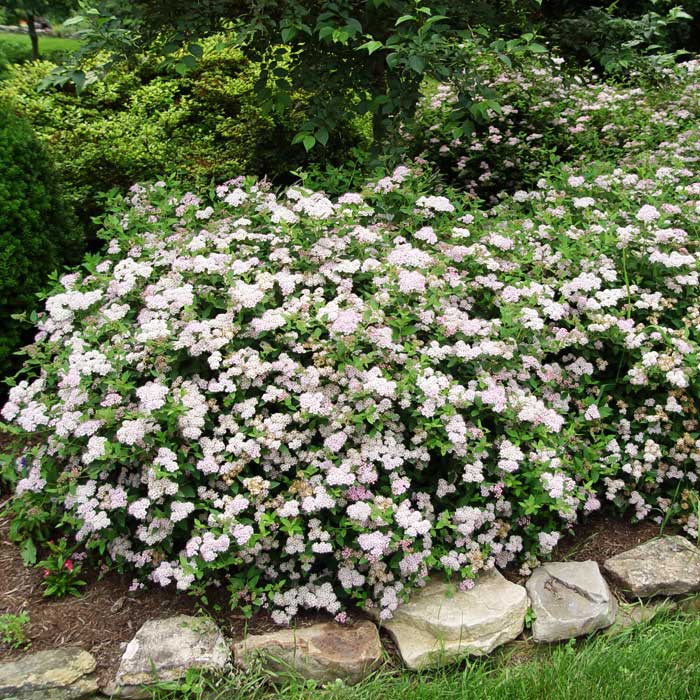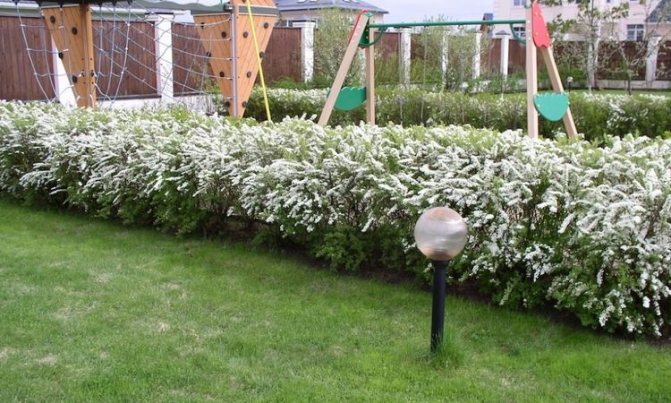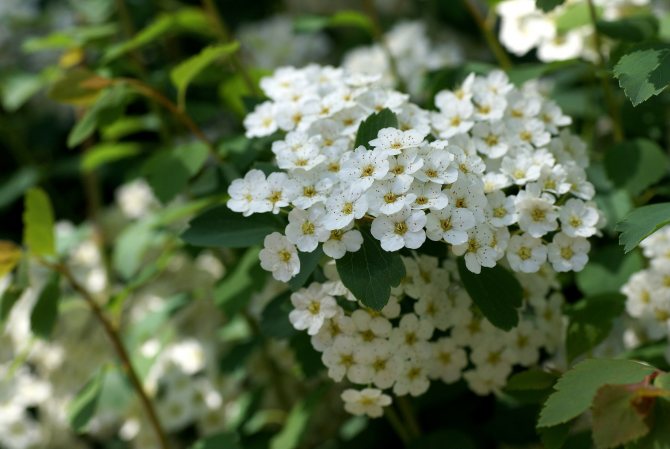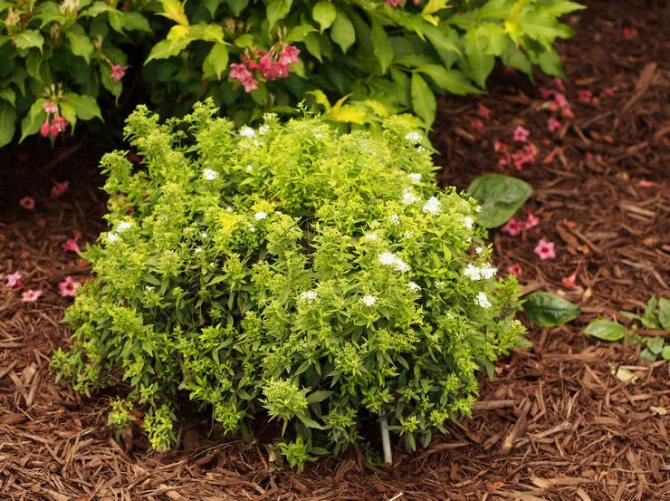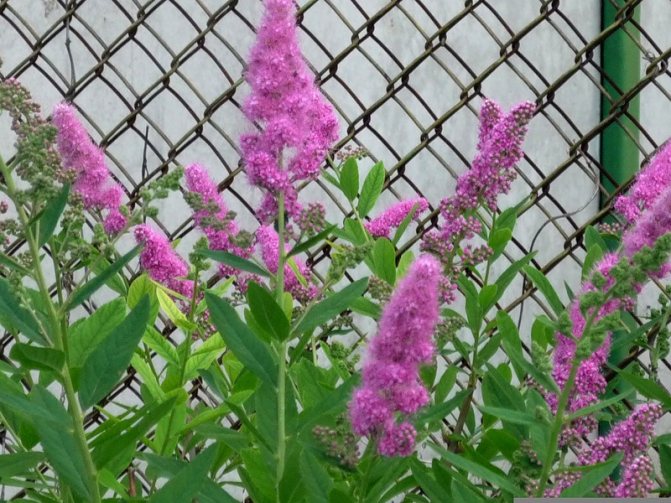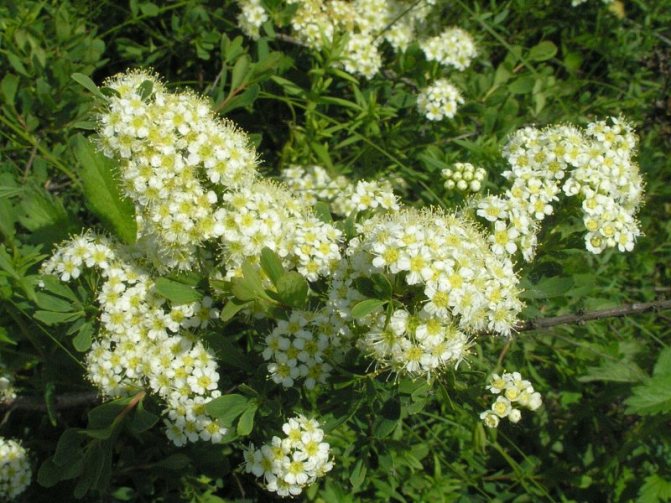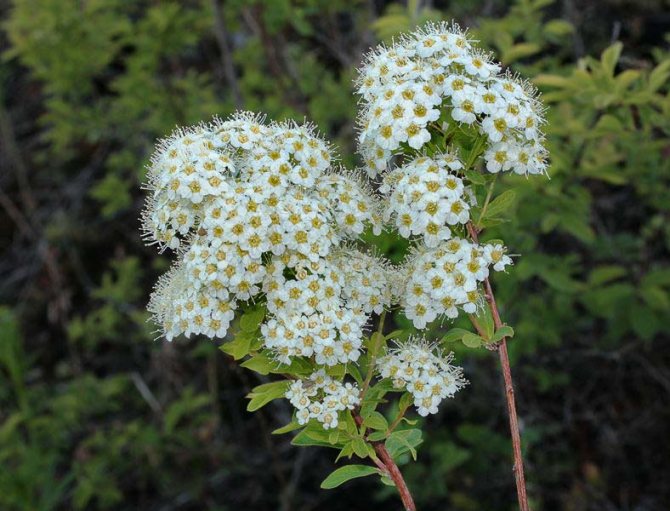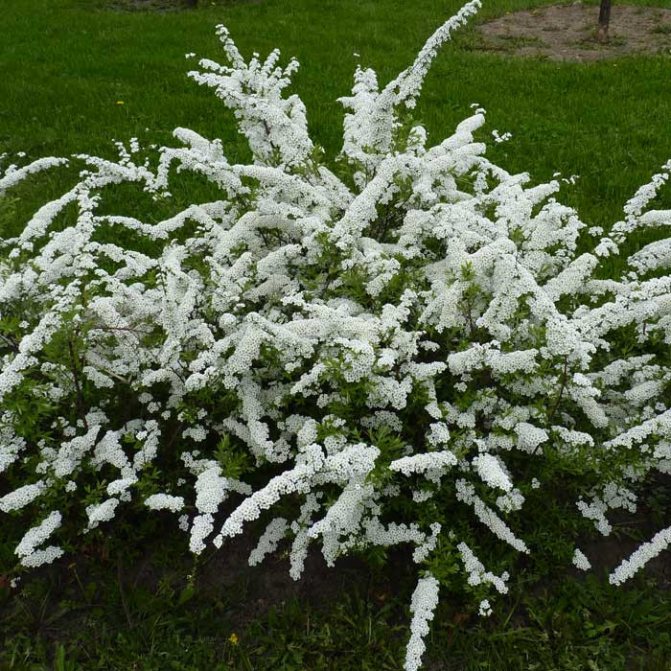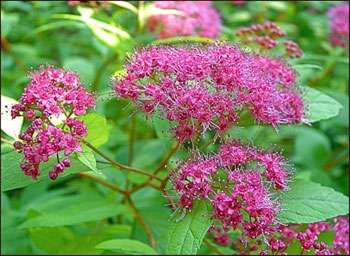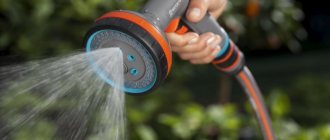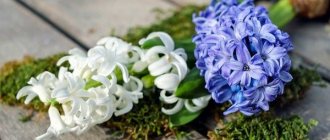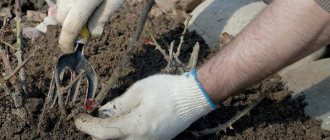Spirea, planting and caring for which is not difficult, can be planted and grown without unnecessary trouble, so the shrub is of great interest and attention for many gardeners. The plant does not require undue attention, but it blooms very beautifully, which is why it is so fond of many summer residents. To grow a gorgeous shrub, you first need to learn the biological characteristics and cultivation techniques ...
Biological characteristic
Spireas are perennial shrubs with a spreading crown. Leaves are simple, alternate on long petioles, pinnate, finger-like, serrate-toothed give the shrub an elegant look, especially in spring. The flowers are small from white to dark pink, collected in paniculate or umbellate-thyroid inflorescences. The refined grace of a flowering bush is comparable to the fragile beauty of a bride, for which the spiraea people received the common name of the bride. The root system is fibrous, spreads in the upper layers of the soil, which makes it possible to plant shrubs near underground utilities. Spireas are resistant to pests and diseases, drought and frost resistant.
The best time for spirea cuttings
Lignified shoots of this plant can be rooted since summer. But most often this is done in the fall. This is much more convenient, since the cuttings will go under the snow in winter and will not need watering or spraying for a long time, and after the spring warming they will take root.

It is recommended to cut woody cuttings at the onset of spring, they can be rooted directly on the windowsill, and in the summer they can be planted in the right place. However, this is a little troublesome, since they will have to be watered and sprayed very often in indoor conditions.
The plant can be propagated by cuttings in spring, summer and autumn. It is recommended to carry out harvesting in cloudy weather, it is possible even during rain. Cuttings should only be taken from a healthy bush. Young shoots are suitable for this. It is very easy to distinguish them from the old ones - when cut with a pruner, they will be green, and the old ones will be brown. If pests appear on the spirea, you should definitely get rid of them with intestinal poison. You can return to the workpiece at least 4 days after processing.
Reproduction methods
Spireas reproduce by seed and vegetative means. From vegetative methods, the reproduction of spirea is used by dividing the bush, layering, cuttings.
Seed
If a large amount of planting material is needed (for hedges), then seed propagation is most acceptable. The seeds do not need stratification and are sown in the harvest year in autumn or spring.
Best of all, Japanese spirea, oak-leaved spiraea, reproduce by seeds), the germination of seeds of which is more than 80%.
For sowing seeds, containers with a height of 20-30 cm are filled with a mixture of leaf and turf soil (1: 1) with the addition of a small amount of humus and sand to loosen the soil. Seeds are sown on a moistened soil surface, sprinkled with peat or a mixture of humus and sand. Cover with foil and place in the shade without drafts. Seedlings appear in 7-10 days. The film is removed. With regrowth up to 2 cm in height, the seedlings dive into other containers.When picking, pinch the central root 1/3 of the length and plant the seedlings at a distance of 5-7 cm.
After 1-2 months, the seedlings are transplanted into a separate bed in open soil and placed on a permanent basis the next spring. Seedlings in the first year are 5-10 cm single-stem twigs. Miniature plants need full care: moderate watering with mulching, top dressing, loosening. It is very important not to trample them or lose them in the weeds. Therefore, it is better to secure the plant with a string through the eight to a wooden marker. The permanently planted seedlings bloom for 3 years. It is better to cut off the first inflorescences. During this period, care consists in timely watering, weed control. Top dressing can be applied 1 time in the spring, no more than 25-40 g / bush of nitroammofoska or other full mineral fertilizer.
Vegetative
Vegetative propagation is used if it is necessary to preserve all the characteristics of the mother plant, if it is not possible to obtain new plants by seed propagation (hybrids). Vegetative propagation allows you to get mature plants faster, but in smaller quantities.
By dividing the bush
By dividing the bush, spireas are propagated at the age of 3-4 years, when the bush is already formed, and the root system allows it to be divided into separate sections, almost painless for plants. By dividing the bush, spireas can be propagated throughout the growing season. Reproduction of spirea in the fall by dividing the bush is most expedient.
We dig out a bush, shake off the soil from the roots. We rinse off the adhered soil and disassemble the bush into parts so that each one has several healthy shoots and a lobe of the root system. Carefully cut the bush with a disinfected pruner. We shorten the roots by 3-6 cm so that the root system begins intensive development and formation of young roots in the soil. We keep the diaper, prepared for planting, in a container with a solution of root root or other stimulant. 2-4 hours.
At the selected site, we dig a planting hole to the depth of the root system. We pour soil on the bottom with a mound and spread the root of the delenka over it. We fall asleep with soil to the middle of the pit. We water and finally fall asleep with soil. Place the root collar at soil level. On top of the soil we mulch with peat, humus, fallen leaves or sawdust (not coniferous). In the first month, in hot weather, watering is carried out in 2-3 days; in cloudy weather, one watering per week is enough.
Layers
For propagation by layering, lower healthy shoots are used. In the spring, we dig a groove from the shoot 8-10 cm deep. Place the shoot selected for rooting at the bottom of the depression, pinch the top, pin it to the bottom with a V-shaped twisted rod and sprinkle it with soil. We keep the soil moist during the summer. For the winter, we insulate with dry foliage, straw, peat. By the spring of next year, the shoot at the internodes forms a bundle of roots. It is separated from the mother plant and planted permanently.
Cuttings
If it is necessary to obtain a sufficiently large number of plants while maintaining varietal characteristics, then the most suitable method of propagation is cuttings. This method is especially convenient for the propagation of hybrids in order to obtain a large amount of planting material.
Cuttings are harvested in spring-flowering spirea species in early June, and in summer-flowering species in the second half of June-early July. For cutting cuttings, we choose a one-year, healthy shoot with vertical growth. We cut separate cuttings with 4-5 leaves from the middle part of the shoot. We remove the bottom 2 leaves completely, and shorten the rest (1/2 leaf blade). Place the lower part of the cuttings in a container with a solution of a root former (epin, root).
We fill the prepared container (pots, small boxes) with sand or a mixture of sand and peat (1: 1). We moisten the substrate and plant the cuttings to a depth of 2-3 cm at an angle of 45 *.From above we cover the container with plastic wrap, it is possible with glass, imitating a greenhouse. Cuttings need high humidity for full-fledged rooting. Therefore, in the first month, we moisten (do not fill with water) the substrate 3-4 times a day and be sure to spray it daily with warm water from a spray bottle (we create an artificial fog). We place a container with cuttings in the shade of a tree, protecting it from drafts. With the onset of a stable cold, we remove the coating, add containers to the ground, insulate with leaves, cover with a box. In the spring, with the onset of heat, we plant the cuttings on a separate bed for growing. We plant the rooted cuttings in the prepared places.
Agricultural technology of planting spirea
When is it better to plant spirea? Spirea can be planted in spring and autumn. In the spring, only summer flowering is planted, with the condition that the leaves have not bloomed on the seedlings yet. The roots of the plant should not be dry, carefully examine the spirea when buying. Shoots should be flexible with good buds. In the case when the roots have been dried, put the spirea in water with the addition of any root formation stimulator (Kornesil, Kornevin, Heteroauxin, Zircon, etc.).
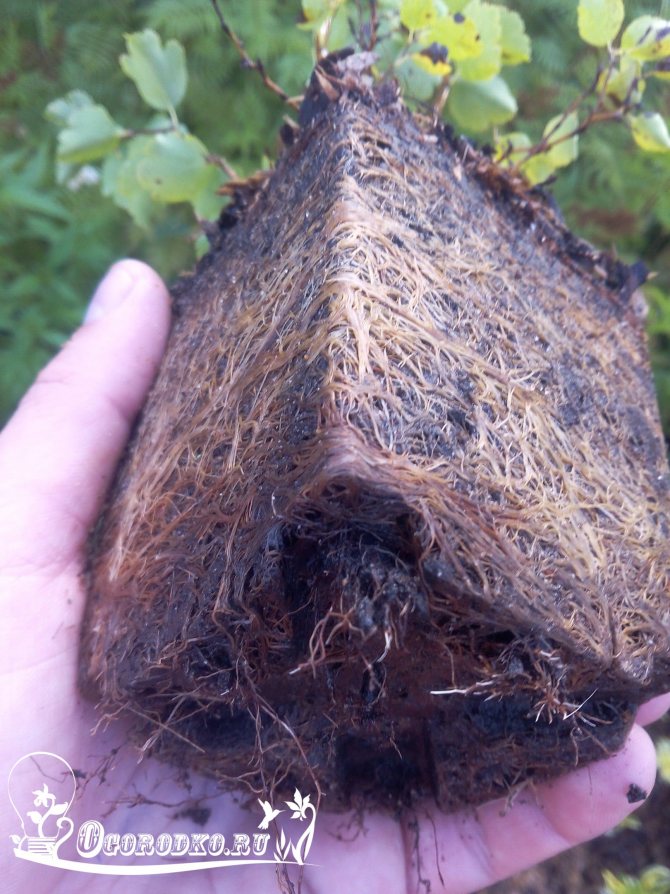

Where to plant the spirea? Choose a sunny, well-lit area with fertile soil. Please note that the shrub grows over time and forms root shoots, so do not plant near tall, large trees. The best neighbors for the spirea will be juniper, thuja, small spruces. Correct planting of the spirea presupposes the presence of a planting pit, which is dug a couple of days before planting the shrub. Drainage from pebbles, chipped bricks, and other materials is placed on the bottom, with a layer of 15-20 cm. For heavy clay lands, it is necessary to add sod, leafy soil (2 parts) and peat chips (1 part). The depth of the hole is dug depending on the size of the root system of the spirea, usually 2.5-3 times more.
The seedling is installed vertically, covered with fertile soil, without deepening the root collar, which should be slightly above the surface of the earth or at the level. It is better to plant a shrub in cloudy gloomy weather or in the evening hours. Watering the spirea after planting is mandatory, pour one or two buckets of water under the bush so that the roots are sufficiently moistened.
In the fall, you can plant spring-flowering and summer-flowering spirea. It is worth noting that the reproduction of spirea is carried out in the fall, by dividing the bush. It is necessary to take into account the timing of planting spirea in the autumn, which have a fairly wide range, depending on the region of cultivation.
Plants are planted before the beginning of leaf fall, with the condition of complete rooting of the plant before the arrival of frost. Usually, in central Russia, spirea is planted in September-October, if the weather permits. In the Urals and Siberia, the work must be completed by October.
Types for home breeding
Types of spiriting are subdivided into 2 large groups:
- spring blooming,
- summer flowering.
Groups (up to 90 varieties) differ in the time and duration of flowering, flower color and where the inflorescences are tied.
Spring-flowered species of spirea differ in inflorescences from white to cream color. Inflorescences are formed on the shoots of the previous year. Bloom in May. Flowering occurs amicably, but its duration is 1-2 weeks. Pruning is carried out immediately after flowering. For home breeding, the most popular are gray spirea, Thunberg, Vangutta, crenate, oak-leaved. All of them differ in the height of the bush and the shape of the crown, the color of the foliage. Very decorative in a lush, boiling white bloom.
Summer-flowering species are distinguished by high decorativeness of inflorescences of bright flowers from pink to crimson. Inflorescences are formed on the shoots of this year. Therefore, pruning is carried out only in the spring. Flowering is bright, long-lasting (more than a month).Many species have yellow, golden, red leaves, which emphasizes the originality of the bush against the background of other plants with a dark green crown. Japanese spiraea (Shirobana, Little Princess), macrophylla, Darts Red, white, willow-leaved are popular in home breeding. Billard's and Bumald's hybrids are especially attractive in color.
Those who are fond of landscape design are probably familiar with such an unusual plant as spirea. A beautifully flowering shrub not only decorates any garden with small inflorescences from spring to autumn, but also pleases with its unpretentious care. Therefore, it is not surprising that once seeing a spirea, any gardener will want such a beauty on his site.
Features of flowering gray spirea
All types of spirea are divided into early flowering and late flowering. This is important to know, since the peculiarities of plant care and pruning depend on it.
Spirea gray refers to early flowering varieties. Flowering begins in May and lasts until about mid-June. The branches are all covered with white shields of inflorescences. Flower buds are formed along the entire length of last year's shoots. The peculiarities of the shearing of these plants are also related to this. If pruned annually, the flower buds will inevitably be removed. This means that your hedge will not please with a hat of snow-white flowers.
Reproduction of spirea by cuttings in spring
And, by the way, the purchase of seedlings is not necessary, because vegetative propagation of the spirea shrub is possible. It's about cuttings in the spring.
Reproduction of spirea by cuttings in spring - cutting off shoots
Cuttings are one of the most effective spirea breeding agents. It is usually held in mid-summer or autumn. But if you wish, you can do this in the spring, in May. In this case, propagation of spirea by green or semi-lignified annual cuttings is used. For spring cuttings, young annual shoots are used, which grow straight and stretch upward. With a sharp knife or pruner, cut a branch into cuttings up to 10-15 cm long. Each should have 4-5 internodes (that is, pairs of leaves). Moreover, the lower internode should be cut off, leaving no petioles. Slices on cuttings should be oblique, at an angle.
Reproduction of spirea in spring - planting cuttings
In general, spirea cuttings root well. However, with the procedure carried out in the spring, special processing of the workpieces is recommended, which promotes rapid root formation. Prepared cuttings should first be placed for 4-12 hours in a solution of any biostimulant at your disposal - Epin, Albit, Energen, Zircon and others. In their absence, experienced gardeners advise using natural biostimulants, for example, aloe juice (3-5 drops in water). It will not hurt to sprinkle the ends of the cuttings with a root-forming stimulant in the form of a powder, for example, Kornevin, Heteroauxin, Ukorenit.
After this treatment, the cuttings are placed in a container with wet sand, deepening at an angle to a depth of 2-3 cm. Do not forget to spray the cuttings, and then place them under a jar or film.
Care and planting of spirea cuttings
When spirea propagates by cuttings, care and maintenance is reduced to placing the pot in a shady place in the garden, frequent spraying, watering and airing. By winter, pots with cuttings should be taken to the basement or buried in the ground. For the latter, cover the cuttings with foliage or natural cloth. With the arrival of warmth, young plants can be transplanted to a permanent place.
| Propagation of apple trees by cuttings Apple trees can be found in almost every garden. At the same time, few people think about the independent propagation of these trees, limiting themselves only to grafting, and after all, they can also be grafted. Read more about the propagation of apple trees by cuttings in our article. | Why does the plum not bear fruit - what to do? Having planted a young tree in their garden, each gardener looks forward to the first harvest. But it so happens that the years go by, but the long-awaited harvest is still missing. Why the plum does not bear fruit and what to do in such a situation, we will try to figure it out in our article. |
| How to water strawberries? The aromatic berries of ripe strawberries are strongly associated with the beginning of summer for many. But in order to get a good harvest of vitamin berries, you need to properly care for it - weed, feed, water. Read about how to water strawberries in the article. | How to water tomatoes after planting? Almost every summer resident is engaged in growing tomatoes on his site. However, beginners often have difficulties and questions regarding the proper care of them. Our article will tell you in detail how to water tomatoes after planting. |
Home Floriculture How best to propagate Japanese spirea (meadowsweet)
Features of trimming spirea gray
Shrub trimming is an important part of maintaining a spirea hedge. To ensure annual flowering, it must be trimmed only after flowering. The method of trimming will depend on what goals you are pursuing. In what cases and how to cut off the gray spirea, we will consider in more detail.
- To reduce the size of the bush and increase its density, you can only shorten its shoots after flowering. This species is remarkable in that it grows quickly and, after pruning, forms many new shoots. The formation of many young twigs increases its density and decorative effect.
- Basic care involves only the removal of old branches that spoil the entire appearance, as well as pruning dry branches. Only frozen shoots should be cut off every spring. So these shrubs are looked after from about seven years of age.
- To rejuvenate the entire bush, the gray spirea must be cut off under the stump. The dormant buds, which are located at the very root neck, come to life after cutting, give a lot of young growth. A new shrub can be formed from it. To do this, leave five or six strong young shoots. And remove the rest in the first growing season. Every couple of years, weak, old branches should be removed.
- In order to form a new bush, pruning should be done in early spring. The shrub will bloom in this case only next year. But sanitary pruning is done in the summer and only after flowering.
How to trim a gray Grefsheim spirea
The characteristics of the Grefshaim variety are similar to the gray spirea, since it is its hybrid. Reddish branches create a spherical crown. This makes the bush look neat and compact. The leaves are greenish-gray in color, hence the name of this type of spirea.
Spirea Grefshaim blooms profusely for a month and a half, starting in May. The variety is very unpretentious. Shrubs grow quickly, so they love a haircut.
A Grefshaim haircut is one of the main elements of grooming. This variety is easy to cut into the desired shape. If you start pruning it in time, then next year it will delight you with abundant flowering.
The best time for a haircut is July. At this time, the Grefshaim variety is already fading. Young twigs that have completed their flowering are cut to strong buds. Old shoots are completely removed.
Adult plants are trimmed ¼ after flowering, while young plants are slightly shortened.
How to trim spirea gray Graciosa
The rounded, spreading crown of the Graciosa spirea is created by thin, decoratively hanging branches. Flowering begins in May and lasts about one and a half months. This variety of spirea grows quite quickly, adding 10-15 centimeters per year.
Spirea Graciosa tolerates a haircut perfectly. If you do not prune in time, then the bushes will take on a sloppy look. To maintain the compactness of the shrubs and ensure abundant flowering in the coming season, it must be properly pruned.Cutting time, like other varieties, depends on the flowering time.
In the spirea Graciosa, the buds are laid in the fall. In May, they begin to bloom. Therefore, spring pruning can lead to the fact that the shrub simply does not bloom. The best time for a haircut is right after the flowering period, around the month of July.
Strong young shoots that have grown this year, it is better not to touch at all. Old and long-flowering twigs can be cut to form strong buds. If the shrub has been growing for more than seven years, then you can safely part with old shoots, dried or broken, cutting them to the very base.
How best to propagate Japanese spirea (meadowsweet)
|
| Flowering spirea |
Beginning of the article:
End of article
Japanese spirea
, like all spireas, it multiplies quite easily.
You just need to remember that varieties, hybrids and decorative forms should be propagated exclusively vegetatively: by dividing the bush, green and lignified cuttings, layering.
The plant is divided
when small young bushes appear at some distance from the main one - they are separated from the mother bush along with the roots.
When landing
in a new place, the soil is pressed to the roots and watered abundantly.
Some more tips
A haircut cannot be ignored if you want a beautiful, healthy and lush flowering shrub. In this case, several rules must be observed:
- The first haircut should be done two years after planting.
- Each spirea shoot develops up to four years, after which the process of dying off begins. If you do not make regular sanitary cutting of the bush, then it begins to dry very quickly.
- Stems over seven years of age are cut completely.
- General sanitary pruning should be done in July when it has fully bloomed.
- A radical haircut involves trimming all branches to strong buds. Broken and dead stems are removed entirely.
- It is impossible to leave stems of the same age on the bush. Ideally, a few old and many new shoots should be kept. Then the death of adult branches will not affect the appearance of the entire plant.
- It should be remembered that the complete rejuvenation of the bush and its pruning to hemp does not always give the desired effect.
Love and care for your plants. And they will thank you with their freshness and beauty.
How to choose and prepare a seedling correctly?
Important! Buy seedlings only from specialized garden centers or nurseries. In this case, you will definitely get what you want.
The first thing to look for when choosing a seedling for planting is the root system. It should be closed, with an earthen lump. Otherwise, the roots may dry out or be damaged during transportation and planting. If the roots are open, then check the lobes - they should be elastic, moist, without blackness on the cuts and breaks. Next, pay attention to the shoots.
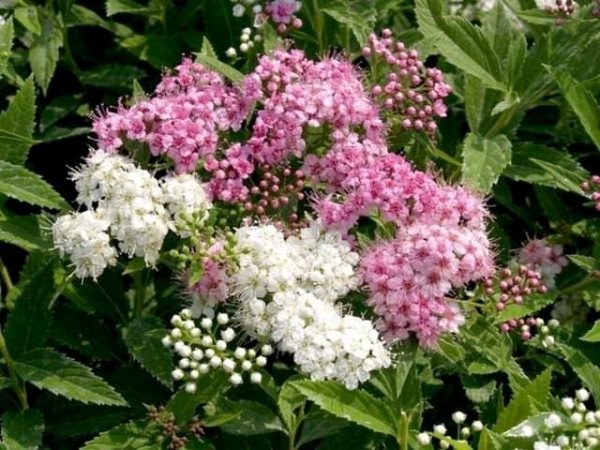

They should not have already blossomed leaves, since such plants are very difficult to tolerate transplanting. Plants with widely spread branches are not worth buying. At the same time, a small number of branches of the second order, on the contrary, is a good sign.
Examine the kidneys and bark. These parts should have a healthy appearance, a good seedling has a light green bark. If the shrub is in a pot, inspect the drainage holes. If thin roots are visible from them, then it is worth walking past such a specimen - this means that the shrub has been sitting in a pot for more than a day and the container has become cramped for it - an earthen lump in this case is covered with roots entirely. In the process of transplanting, the roots may be damaged, and the meadowsweet will not take root or will hurt for a very long time.
Reproduction by dividing the bush
Orchid baby on a peduncle: examples of how to grow and root
You can also choose to divide the bush as a growing method.It is suitable for shrubs that are 3-4 years old.
Important! It is better not to separate mature plants in this way, as there is a risk of damage to the root system.
You need to dig out the shrub, place it in a bucket of water, hold it for several hours, then divide it into 2-3 parts using a pruner. It is important to prune the roots before planting. Then the spirea should be watered abundantly after planting, especially in hot weather.
Spirea - fluffy clouds in the garden. Planting, care, description, types
Spirea is a shrub that attracts attention with its lush flowering, spectacular color of leaves and inflorescences, the size and size of the bush, as well as unpretentiousness and endurance, this plant can be used in any type of landscaping. But in order for the spirea to show all its decorative "capabilities", you need to know some details of caring for it... Let's get to know them.
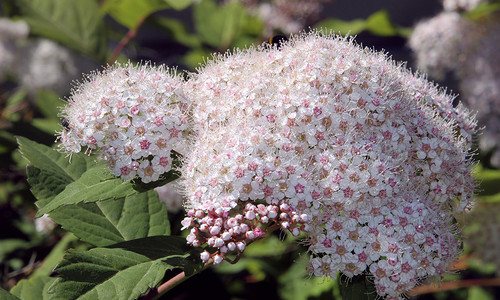

Content
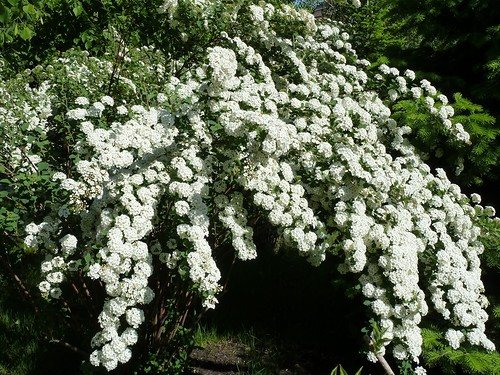

Pruning for rejuvenation
The life span of some types of spirea is 20-25 years. One stem lives for 6-7 years. The old bush sometimes loses its attractiveness, is affected by pests, so it is betrayed by deep pruning. Such a shrub is completely cut to the ground. In the spring, dormant buds will begin to sprout near the root collar. Thus, the spirea will completely rejuvenate.
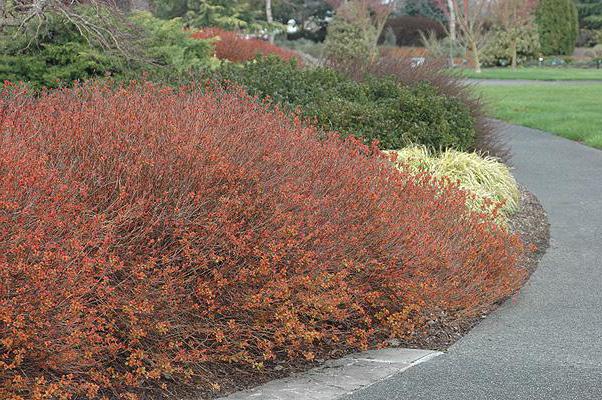

Use in landscape design
They strive to show Spirea, since it is a crime to hide such beauty. She is given the sunniest place on the site, since she is very photophilous. Low-growing varieties are used to decorate borders. It goes well with other, higher shrubs: lilac, viburnum, mock orange, rhododendron, barberry.
The choice in favor of this option is also made for the design of hedges, since the plant tolerates pruning well. At the same time, the cost of seedlings is affordable, and the shaping process is not complicated.
Important!!! When choosing a spirea to form a hedge, remember that with frequent pruning, you should not wait for the flowering of the bush. Choose a variety with beautiful foliage - it will make up for the lack of flowers.
Types and varieties of spirea
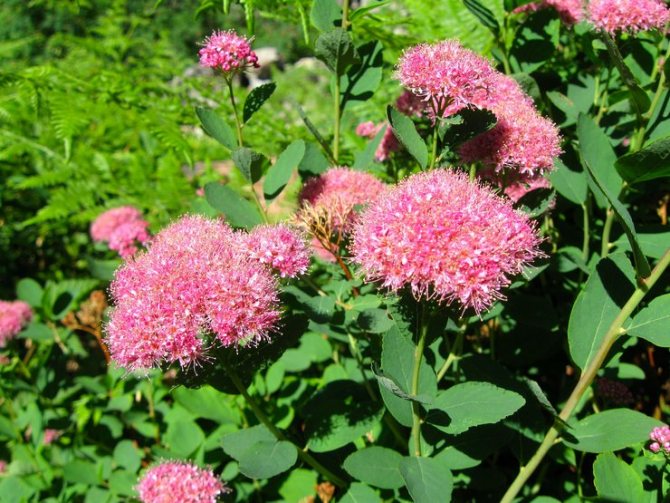

Spireas blooming in spring are distinguished by white flowers during flowering and strong tillering. The most popular are the "Gray" spirea and its varieties "Grefsheim", "Vangutta", "Nipponskaya", "Arguta".
Summer-flowering spireas attract the eye with red-pink hues during flowering. This spiraea "Japanese" and its varieties "Little princesses", "Golden princesses", "Shirobana", "Goldflame", "Crispa", as well as spirea "Bumalda" and its variety "Goldflame", spirea "Ivolistnaya", "Douglas ", Billard".
All species, varieties and hybrid varieties are not similar to each other and have their own individual differences - the shape, splendor and volume of the crown, the height of the bush, the shape and shades of inflorescences, the duration of flowering and the rate of growth, the popularity of cultivation in culture.
Diseases and pests
The plant is very resistant to most dangerous diseases, but sometimes gray mold or spotting can appear on the bushes. These are fungal infections, for which fungicidal agents are needed, for example, foundazol or phytosporin-M. There are also pests that can damage the bushes if measures are not taken in time. Their list includes:
- rose leaf roll. May appear on shrubs in late spring and damage leaves. To eliminate caterpillars, it is necessary to use pyrimor;
- spider mite. In the presence of ticks, the leaves of the spirea begin to turn yellow, and a thin web appears on their underside. For pests, plants need to be treated with karbofos, acrex preparation or tincture of tobacco dust;
- aphid. This pest can be found in summer, aphids can damage both leaves and flowers. To eliminate it, you will need to treat the bushes with tincture of tobacco dust or pyrimor.
Damaged shrubs, treated with drugs, should stand for at least a day, covered with cellophane.If necessary, the procedure must be repeated several times and the bushes should be opened only after the complete elimination of the pests.
Mineral fertilizers
Flowering bushes are well suited for urea and nitrate: calcium, potassium and ammonium. Nitrogen fertilizers must be used in combination with phosphorus fertilizers. In the first half of summer, emphasis is placed on the first group of dressings (they promote growth).
At the end of summer, you cannot feed the bush with mixtures containing nitrogen, as they can provoke the growth of new shoots, which will not have time to fully form and will die in winter.
| Fertilization rates, (g per m²) | ||
| Saltpeter | Ammonia (NH4) (NO3) | 10-15 |
| Calcium Ca (NO3) 2 | 20 | |
| Potash KNO3 | 20 | |
| Superphosphate (CaH2PO4) 2 x H2O + 2CaSO4 x 2H2O | 35-40 | |
| Urea CH4N2O | 30 | |
- Mineral mixtures are applied before flowering.
- All dressings can be introduced both in dry and liquid form, combined with watering.
- If the fertilizer consists of granules, then they must be scattered near the plant. Application rate: 70-100 g per 1 m².
- A solution of phosphorus and potassium fertilizers is poured into a recess made at the base.
- The next day after the introduction of top dressing, the soil is loosened.
Spirea is very useful: it serves as a decoration for the garden, has a good survival rate and long flowering, unpretentiousness, gas resistance (in a city), has phytoncidal activity (disinfects the air). Many species of this plant are considered medicinal (decoctions and infusions of bark, flowers and shoots of spirea willow leaf have antifungal effect, etc.), are honey plants, are used to strengthen slopes and ravines.
Common mistakes of beginners
The main reason for the death of an ornamental shrub in winter is considered ignorance or violation of the technology for caring for spirea in the fall. The most common mistakes that negatively affect the endurance and winter hardiness of the crop are excessive soil moisture, the introduction of nitrogen-containing mineral fertilizers and late pruning of shoots.
Many novice gardeners choose the wrong covering material for insulating spirea. Roofing material and plastic wrap do not allow plants to "breathe". The lack of normal air exchange leads to the formation of mold on the shoots and rotting of the root collar.
How to rejuvenate a shrub?
Mature specimens over 15 years old require anti-aging pruning. The event is carried out in the fall by completely removing the aerial part of the bush at the level of the root collar. The same scheme applies to a plant that has been severely damaged by pests. After such a cardinal intervention, summer-flowering varieties will bloom in the next season, and spring ones only a year later.
Advice
Do not leave stumps after clipping. Young thin and weak twigs will grow from dormant buds on pruning in spring.
Growing spirea by layering
Obtaining cuttings is suitable for those who need several shoots from one bush at once. This method of growing is best done in early spring, choosing shoots from the bottom, which need to be slightly broken, fixed on the ground and sprinkled with soil. At the main bush, you need to cut off the inflorescences so that it spends energy on the appearance of roots in the shoots. The soil under it should be slightly damp all the time. At the end of the season, the cuttings will have their own root system, but they can only be transplanted next spring.
Features of care and preparation for winter - general tips and tricks
In order for the plant to benefit from the care rendered, all actions must be carried out exactly with the recommendations. Autumn care for spirea includes the following necessary manipulations.
Watering. Spirea has good drought resistance, so the shrub is unpretentious to watering. It is necessary to moisten the near-stem circle of a flowering plant only if it is dry autumn. To completely saturate the bush with moisture, 15 liters of water are introduced under the root of an adult bush.
Important! The next watering can be carried out only after most of the earthen coma dries out: the roots that have been in contact with wet soil for a long time rot.
Top dressing. In order for the spirea to gain strength before winter, phosphorus-potassium fertilizers are applied under the root of the plant in doses indicated by the manufacturer.
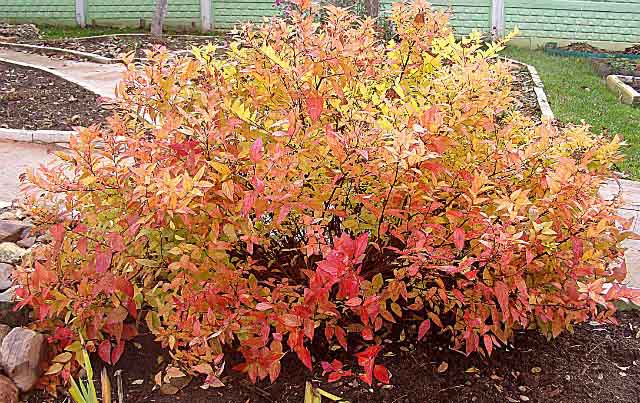

note! Despite the nutritional value, mullein cannot be added: it contains a lot of nitrogen, which stimulates the formation of young shoots, as a result of which the plant wastes the energy accumulated for wintering. For the same reason, nitrogen-based mineral fertilizers are not used for the autumn feeding of spirea.
Pruning. Such fast-growing shrubs as spirea need to be cut off annually so that the plant blooms luxuriantly and has a decorative look. In addition to the aesthetic component, garden manipulation is an excellent prevention against fungal diseases.
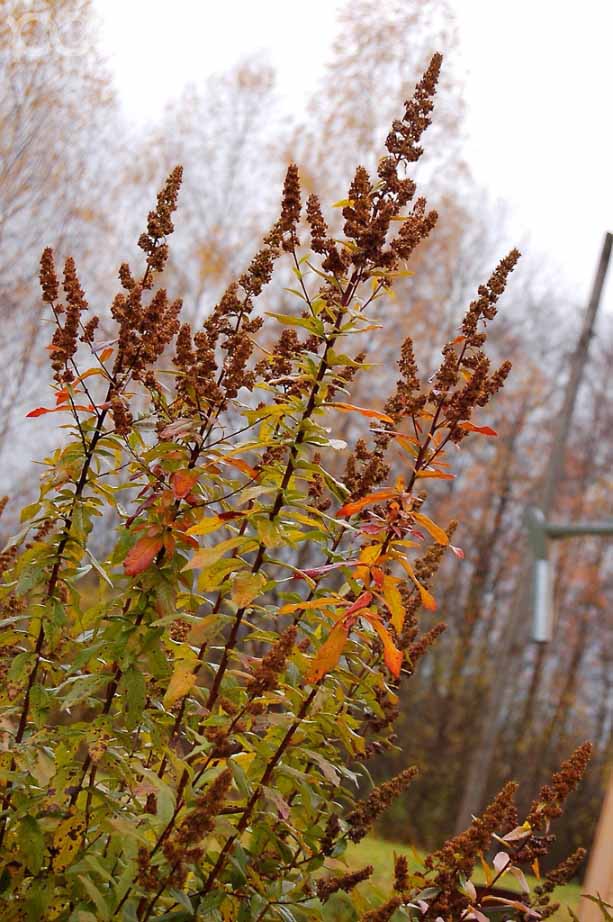

Mulching. Despite the fact that the spirea is endowed with excellent cold resistance for reinsurance, the roots of the shrub, which are located close to the surface, are covered with a layer of peat, leaves or hay. The same mulch is placed on top of bent shoots to protect them from frost.
Shelter. Most varieties of spirea are endowed with high frost resistance: the bushes can withstand a drop in temperature to -35 ..- 50 C. Only species such as Japanese spirea, white-flowered and nippon suffer from frosts in the middle zone. At the arrival of spring, the owner of such spirits often discovers freezing of the tips or all of the shoots.
Video: caring for spirea, including in the fall and in preparation for winter
Preparing a place for a spirea
Preparation for planting this shrub consists in drawing up a site plan. You need to correctly distribute plants throughout the territory in order to choose the right place for meadowsweet. Regardless of the variety, these shrubs feel great in sunny glades and in a small shade. In the sun, they give more flowers, but in the shade, the color of the discarded brushes will be more intense, and they will last longer on the branches.
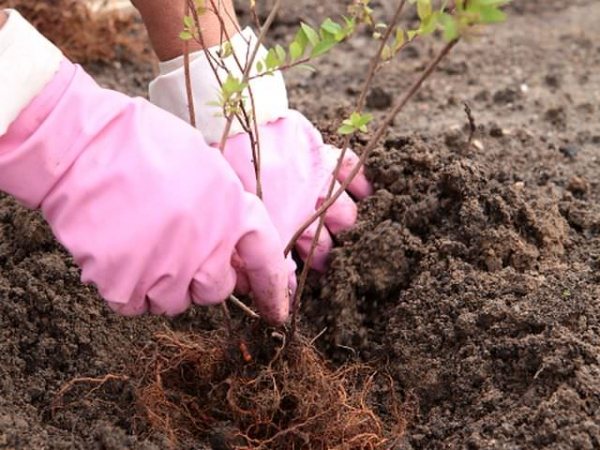

It is best to place the plant in an area with watertight soil and moderate moisture. With sod or leafy soil, you can make the right type of soil yourself. Peat and sand need to be added to clay soil, and some varieties of spirea cannot stand calcareous soils, for example, this feature is characteristic of Billard.
Important! Like all other plants, meadowsweet survival is much better if planted on a cloudy day. Otherwise, she will be ill for a long time.
Hedge modeling
A spirea hedge is an excellent solution for a garden plot. It will protect your property from dust and exhaust fumes, serve as a decoration and screen from prying eyes, without causing heavy shading.
After the autumn adjustment of the hedge shape, be sure to add potassium-phosphorus fertilizing and mulch the soil. Such a measure stimulates the healing of wounds, will help spirea in preparing for the winter.
Systematic hedge trimming allows you to:
- achieve density by stimulating branching of shoots;
- to give the plant fence a compactness, a certain silhouette, height and shape;
- maintain the health of the hedge by improving ventilation and illumination of the bushes.
Modeling hedges is started a year after planting. Young bushes are pruned, removing a third of the annual growth. After 2-3 years, you can cut up to half of each twig to maintain the shape of the green fence. As you age, periodically trim the shrinking branches inside the crown.
Important!
Low pruning of the old fence will lead to the risk of drying out or freezing, since old bushes have an increased tendency to bare the root collar.
Which variety should you choose?
The question of choice is in most cases a question of the taste of the future owner. All species are unpretentious, bloom beautifully and have minor differences.
Important!!! When choosing between hybrid and non-hybrid, opt for the first option. Although hybrids are more difficult to reproduce, they are superior in beauty to ordinary varieties, and are distinguished by amazing vitality.
Miniature varieties are usually chosen for bonsai and border decoration.
Important!!! When choosing a seedling, take a closer look at the shoots - they must be flexible, with strong buds - these are signs of a healthy plant.
Where to buy seedlings?
Buying a plant is as serious a matter as buying solutions for the interior of the interior space. It is worth taking this seriously. Don't buy seedlings from random people, find a good nursery in your area. The cost will differ slightly, and the confidence that the purchase will meet expectations will be one hundred percent.
Another purchase option is an online store. We will not consider printed catalogs that arrive by mail, as fraudsters often engage in such mailing. Online stores of seedlings and seeds can be checked for integrity by looking for customer reviews. Even if the purchase of a spirea is not such an expensive investment, it is still a pity to give your money to unscrupulous suppliers who will not guarantee you the quality of the goods sent.
The correct approach to buying, adherence to elementary planting rules, minimal care will allow you to grow a beauty on your site that will delight and delight for many years.
Pruning varieties that bloom in summer
Several varieties of spirea have been bred, which bloom in the summer months. Such bushes have bright lush inflorescences of pink, purple or soft coral. Of late-flowering varieties, Japanese, willow, birch-leaved spirea can be distinguished. This group also includes the Billiard, Douglas, Bumald varieties.
In the first year of planting, the bushes are not cut off at all. The next year, pruning of spirea in the fall is carried out insignificantly, only weak shoots are removed. They also form a bush by removing faded parts of the branches. Cut off shoots in spring begin to branch out, and an abundant crown is formed. Light penetrates better to a thinned plant, it is well ventilated. Sanitary cutting of shrubs prevents the occurrence of fungi, various infections and the appearance of pests.


Spirea care
Freshly planted plants and plants need regular watering during hot dry times. Especially you need to pay attention to Japanese spirea, because without sufficient watering it can dry out and die.
Weeding and loosening
Young plants need to be weeded out. You also need to periodically loosen the soil under them, because when weeding and watering, it becomes denser.
Mulching
It is good to mulch the soil around the spirits with peat, sawdust or husks from seeds, nuts or buckwheat. The height of the mulch is 6 to 8 cm. This helps to keep the soil moist and loose for a long time, and also reduces the amount of watering.
For full development and lush flowering, it is advisable to feed the bushes with fertilizer with nitrogen, phosphorus, potassium and trace elements (for example, Kemira-Lux). This is done in early spring.
Spireas blooming in July-August, it is also advisable to carry out one more top dressing in June.
To preserve the strength of the spirea, which goes to seed formation, you need to remove the inflorescences after flowering.


Haircut to stimulate flowering
To make the spirea bloom better, cut the shoots at the very tips. To do this, it is enough to remove a third of the length of the flowering part of the branch. This pruning stimulates the formation of side shoots and abundant flowering.
Once every 4 years, it is useful to renew the shrub by cutting off branches at a height of 30 cm from the ground. This pruning can be done in spring or fall.It is important to do it 2 weeks before the onset of frosty weather, so that the plant has time to recover. In the spring, such a pruned bush will begin to actively renew itself: lateral shoots will go from each branch, which will bloom profusely in July.
Winter covering activities
Now let's figure out how to properly cover the spirea for the winter. The root collar and the base of the branches are mulched, but the crown can be left intact or insulated with a covering material. To prevent the wind from breaking thin shoots, it is recommended to collect all the branches in a bunch and tie them with twine. The formed bundle is insulated with dry opal foliage or pine spruce branches, the top of the shrub is covered with burlap, white polypropylene bags, agrofibre, lutrasil or geotextile.



